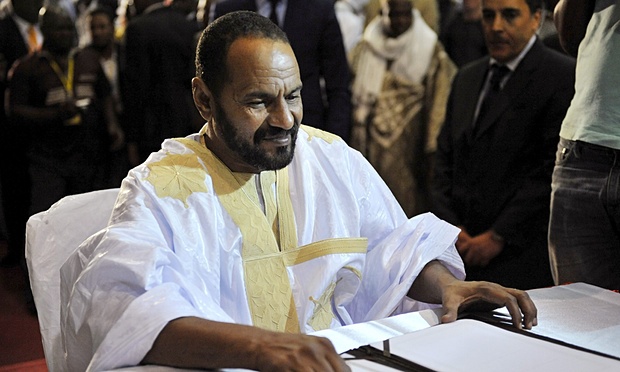Northern Azawad rebels agree to ‘federalism in all but name’ with Bamako, formally ending conflict that erupted in January 2012.

The rebels of northern Mali, represented by the Coordination of Azawad Movements (CMA), finally agreed to sign the agreement for peace and reconciliation in Bamako on 20 June, crowning almost a year of talks that have been taking place in Algiers. The unusual possibility that a peace agreement might be signed in the absence of one of the belligerents is therefore thankfully no longer on the cards.
A reception for the Tuareg and Arab rebel leaders, who still control huge expanses of the country, was an event in itself, given the Malian capital’s deep-rooted hostility to their cause. They had missed a previous ceremony on 15 May, leaving a strong sense that the job was only half done.
The international community kept up its pressure to the end, finally convincing the Azawad rebel groups to end the conflict, which erupted in January 2012 after simmering for five decades. Perhaps the imminent commencement of Ramadan – the Islamic month of forgiveness – helped. But the Malian authorities made further concessions too, such as tearing up arrest warrants for 15 CMA members. The insurgents feared total isolation, their resources were exhausted and the conflict was bogged down.
The final talks in Algiers took into account some of our political demands – in particular the commitment by the Platform [a coalition of several pro-government militia groups] to withdraw from Menaka, and the international community’s formal pledges to see the process through to its end – convinced us to sign, said Ambeiry ag-Rhissa, chair of the CMA political committee, before the official ceremony which saw signs of cautious but genuine reconciliation.
Ag-Rhissa recalled many broken promises and still fears the Malian state’s obsession with the myth of sovereignty, but he believes that the latest solution is the least ill that’s been found in 50 years’ conflict. His organisation nevertheless had to accept a form of federalism in all but name, as an African diplomat put it.
Reflecting a widespread feeling, a European diplomat voiced his relief but added a warning. The difficulty for Mali is not signing yet another peace agreement, but applying it, he said. The various players are so fragile and the inertia rooted in political practice is so great. French foreign minister Laurent Fabius was more optimistic, hailing an excellent agreement.
However many questions remain. How will the Malian army be reorganised, before being redeployed in the north? What status will the Azawad regions enjoy in Mali as a whole? In view of the previous total lack of trust between the various parties, the international partners will have plenty to do, supervising the resolution of many outstanding issues.
There is also some doubt about the degree of loyalty commanded by the leaders of the two sides. In his closing speech, President Ibrahim Boubacar Keita spoke of a marvellous day, promising that no one will be disappointed. But two years after his triumphant election, endorsed by almost 80% of voters, he is increasingly unpopular. Speaking off the record, a regional representative said: We call him the man who isn’t there, because of all his trips abroad. A majority of the population is against any concessions to the rebels, who they blame for the country’s collapse. Meanwhile, CMA leaders will have to contain those who feel betrayed and are determined to carry on the armed struggle to liberate Azawad.
Meanwhile, new or reformed militia groups are stirring up antagonism between the peoples of the north. The conflict is no longer just a stand-off between the central government, in the south, and Azawad rebels. The various Platform groups are filling the gaps left by depleted army forces, but their leaders are also acting in their own and their community’s interests. The capture of Menaka in late April by the Imghad and Allies Tuareg Self-Defence Group (Gatia) is indicative of such mixed motives.
Lastly, despite the efforts of the French military, which has eliminated several jihadi leaders in recent months, Islamist groups remain quietly active. Scattered all over northern Mali, they now threaten the whole country. Several violent attacks have occurred in the Mopti and Ségou provinces, in the centre of the country. They are thought to be the work of the Macina Liberation Movement (FLM), an Islamist group rooted in the Fula ethnic group. In the south, Bamako saw its first attack on 7 March, followed by Misséni, a small town on the border with Ivory Coast on 10 June.
The mandate for Minusma, a UN mission set up in 2013 to support the country’s political processes, is currently up for renewal. At a security council meeting last month the commander of peacekeeping forces in Mali, Michael Lollesgaard, deplored the major shortfalls which make his forces extremely vulnerable. He speaks from experience, having survived an attack on his convoy in May.
This article appeared in Guardian Weekly, which incorporates material from Le Monde





